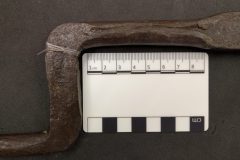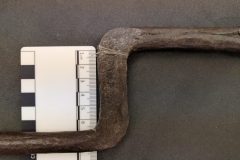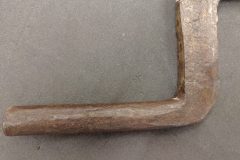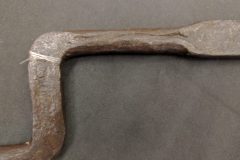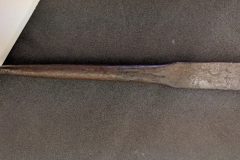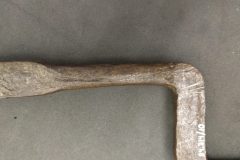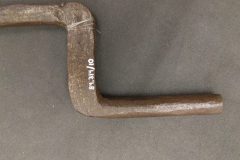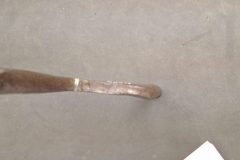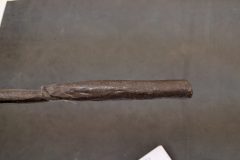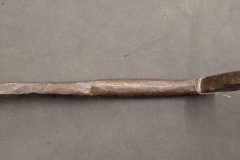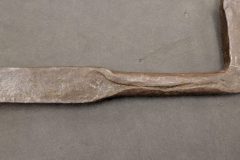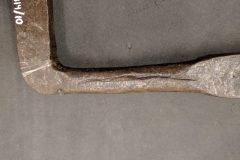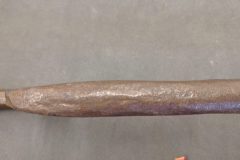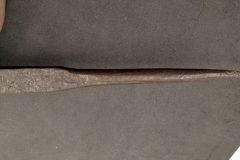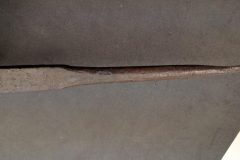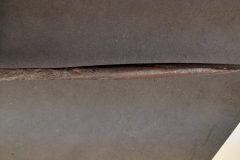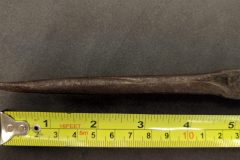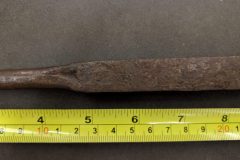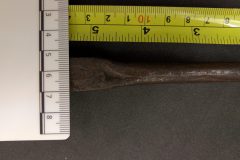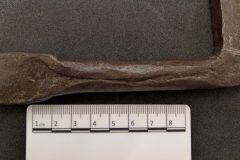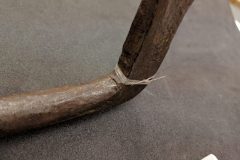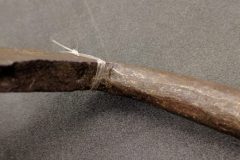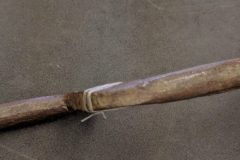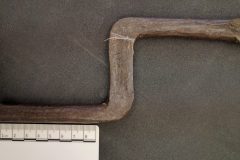In 2016 I visited the Museum of London to take a look at their iron roasting spit, item no. 84.314/10. Unfortunately there’s not a lot of detail listed for the item, and before I visited there was even less…one of the quid pro quo’s for having the item taken off display (it normally lives on public display in the medieval gallery ) was to provide detailed measurements to add to the catalogue description and I thought some of you might be interested in them.
Although it’s catalogued as late 15th/early 16th century in date, if my memory of the conversation is correct, it was a river find from the Thames so is speculatively dated and more likely to come from the latter end of that range, if not the early seventeenth century.



The spit is made from flat iron bar which has been forged to a point at one end and shaped into a crank handle at the other, leaving the working blade section in the middle.


The crank consists of a slightly barrel shaped axle, a vertical rectangular section and a cylindrical handle.


The 75mm long axle has been created where the bar has been forged down from rectangular bar to a roughly round section 12mm diameter at the junction with the main spit blade, 14mm diameter at the mid point and 10mm diameter at the junction with the vertical bar.

The vertical section of handle has been left rectangular, though slightly narrower than the main blade of the spit, and is approximately 18mm x 8mm x 70mm. This flat bar has been bent at right angles to the axle but shows signs of a fracture at the radius of the bend as if the bar was bent past 90 degrees whilst hot but straightened up when the metal was too cool to work efficiently

The last 90mm-110mm of the handle end of the bar has been forged down to a cylindrical shape approximately 15mm in diameter and then bent at right angles to the flat bar to create the hand grip.

The point end has been shaped in a similar fashion to the handle, with the bar being forged to a conical shape, 12mm in diameter at the junction with the main blade and approximately 7mm in diameter at the point. The last 15mm of the point have been left faceted rather than fully round.

The blade of the spit tapers in width and thickness along its length changing from 24mm x 8mm at the crank end to 16mm x 7mm at the point. This taper, though slight, has been seen in later period spits and from a practical standpoint assists with removing roasted joints of meat from the spit at the end of cooking.
The item as a whole is in very good condition with only minimal nicks and damage.
The blade length of 950mm (around 3ft 1″) tallies quite nicely with the size of a statute billet (as I discussed back here ), especially as the 3ft 4″ length of each billet would include the carf or cut point meaning that most of the usable wood would be much shorter than the statute length…hopefully this appalling sketch will clarify that somewhat (though i really do doubt it!)

The gallery below includes all the halfway usable images that I took…typically the one thing I completely forgot to take was my camera so I had to rely on my mobile phone to do the job.
Finally a huge thank you to Hazel Forsyth at the Museum of London for arranging to have the spit taken off display for me to view.
TTFN








